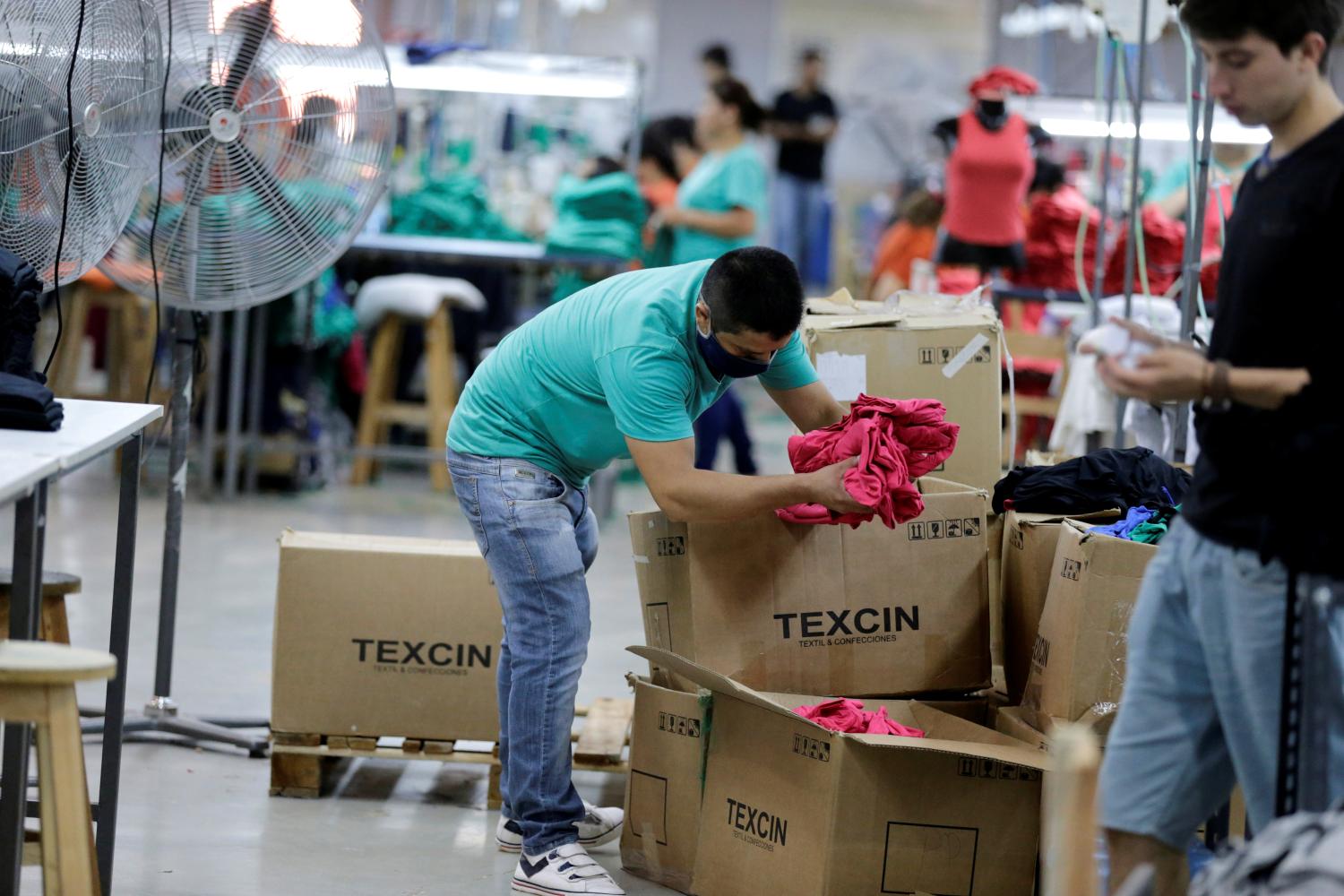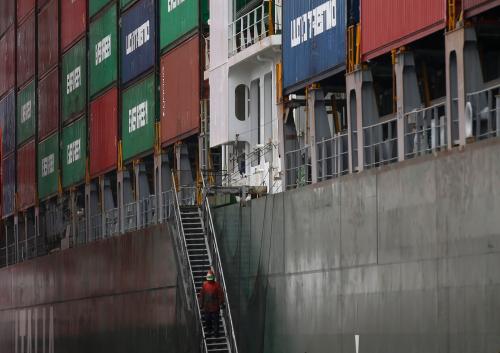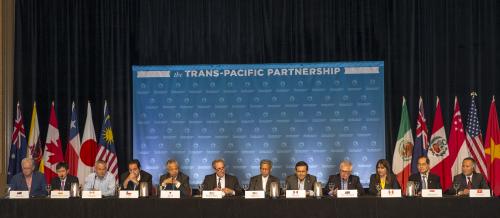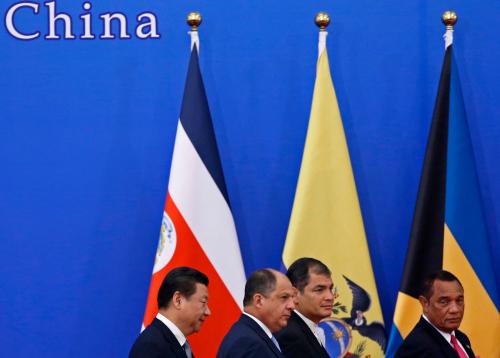A New Trade Environment
Across Latin America and the Caribbean (LAC), governments are asking how they can spur growth in a challenging and uncertain global context. Beginning in the early 2000s, the region benefited from a confluence of favorable external factors: rapid growth in China and other key emerging markets, record-high commodity prices, and brisk capital inflows. These conditions—only briefly interrupted by the 2008-2009 global financial crisis—propelled an unprecedented period of export-led growth. Trade increased on average over 15 percent a year during this time, and exports outpaced imports by an average of $17 billion a year. However, the conditions that facilitated this strong performance have receded into the distance, and since mid-2014 global trade has suffered a significant contraction. LAC’s trade performance has suffered in turn with exports falling 15 percent in 2015 and 6 percent in 2016.[1] The “easy” gains based on buoyant external conditions are a thing of the past.
Recent economic and political developments have introduced additional headwinds in the form of growing opposition to free trade agreements (FTAs). These trends create the potential for an uptick in protectionist measures that could further dampen global trade growth in the coming years. With the political will for in-depth FTA negotiations on the decline in many of LAC’s key trade partners, the region will need to focus on other policy tools to kick start trade. The silver lining is that arguably the most important steps to reduce trade costs and deepen integration in LAC do not depend only on further FTA negotiations or the status of major global and mega-regional trade deals.
To understand why, it is helpful to consider how the region’s trade policy has evolved over the last few decades. LAC enthusiastically embraced trade liberalization in the early 1990s, cutting tariffs and signing a host of bilateral and regional trade agreements, a trend that continued in many countries in the region during the 2000s. This focus on FTAs and tariff reduction was necessary at the time and has benefitted the region.
However, LAC now needs to look beyond the “traditional” trade agenda, since FTAs cannot adequately dealt with several key trade barriers. These include issues such as transportation and logistics costs, customs-related trade costs, regulatory costs, informational trade barriers, and coordination of transnational production costs, among others. Additionally, LAC’s current trade architecture is characterized by multiple, overlapping FTAs, where subsets of countries are party to several agreements among themselves. The resulting “spaghetti bowl” of agreements raises transaction costs and discourages production chains at the regional level.
The region can ill afford to leave these barriers in place given the broader slowdown of the world economy, the prospects for further FTA negotiations, and the increasingly exigent nature of international trade, in which complex global value chains (GVCs) put a premium on seamless logistics and just-in-time delivery. This essay discusses some of the key trade barriers holding back growth in the region.
The rise of global and regional value chains
The recent trade slowdown makes clear the urgency of a policy framework to identify and exploit opportunities to diversify exports and thus buffer the region from commodity price cycles. In searching for such opportunities, it is crucial to keep in mind the particular features of contemporary trade, especially in manufacturing, but also increasingly in services. Policies to promote export diversification must be attuned to the demands of global value chains, in which trade between countries is defined by joint production of goods (rather than exchange of final products), with raw materials, intermediate inputs, services, and production “tasks” being contributed by various countries. The rise of global value chains has been driven by large multinational corporations, which determine the structure of GVCs through their sourcing and location decisions.
Global value chains can allow developing economies to diversify exports more quickly by specializing in a single component or phase of production—for example, microchips—rather than building a vertically-integrated industry to a produce a final product such as computers. However, LAC’s participation in GVCs remains low, suggesting the region has not taken full advantage of these opportunities. The share of intra-industry trade in LAC’s total trade, a common indicator of value chain insertion, stands at around 20 percent—well below that of Asia, where intra-industry trade rose markedly during the 2000s to reach nearly 45 percent by 2010.[2] Similarly, LAC’s exports incorporate less foreign value-added than do the exports of Asia (by 12 percentage points) and the European Union (15 percentage points), meaning exports in those regions incorporate more foreign inputs in their production process. The story is much the same for downstream linkages, or the portion of a country’s exports that end up being used as intermediate inputs in the exports of a third country (so-called “indirect value-added”). LAC countries export relatively few inputs for manufacturing industries: the share of parts and components in LAC’s total manufacturing exports was 14 percent in 2010, compared with 40 percent in Asia. To the extent LAC does participate in supply chains, it tends to be in its traditional role as a source of raw materials.[3]
What explains the region’s weak insertion in GVCs? Public goods such as high-quality transportation infrastructure, reliable communications networks, and efficient customs processes are critical for the coordination of complex relationships among firms and the efficient exchange of products and services that characterize GVCs. Indeed, a multinational corporation’s location decision—a key determinate of the geography of global value chains—is strongly associated with a country’s performance on infrastructure indices.[4] All LAC countries could realize considerable gains in the number of multinational corporation affiliates by improving their logistics infrastructure to the average level of the EU. Other issues such as customs-related trade costs, information constraints, and regulatory overlap also inhibit LAC’s participation in value chains—issues that too often receive inadequate attention of policymakers. The next sections discuss these issues in turn, arguing that they must be at the center of the region’s trade policy.
Trade facilitation
One key trade bottleneck in LAC is at the border. While customs and other border authorities perform a critical role in the oversight and accounting of trade operations, they can also increase the average time to ship products across nations and introduce uncertainty that undermines competitiveness in a global economy defined by flexible production processes and just-in-time delivery. In order to streamline the customs process and minimize such costs, countries throughout LAC have begun to implement trade facilitation measures, in the context of some multilateral initiatives (e.g., WTO Trade Facilitation Agreement) or regional initiatives. These measures include the implementation of modern single windows for foreign trade, authorized economic operator (AEO) programs, and other coordinated border management initiatives.[5]
There is a growing body of evidence showing that trade facilitation interventions can have a significant impact on exports. Evidence from Uruguay, based on firm-level data on customs operations, shows that if all shipments subject to physical inspection cleared customs within one day, exports would increase by a full 5.9 percent.[6] Other studies by the World Bank and OECD, among others, have found gains on a comparable scale. In light of these benefits, trade facilitation deserves to be front and center in the region’s trade policy. Indeed, governments across the region have already taken important actions to bring down customs-related trade costs. More than 20 national single windows are currently in operation in the region, and 11 countries have implemented AEO programs, certifying companies as secure trade operators.
In order to get the most out of these initiatives, coordination and cooperation are paramount. For example, interoperability of single windows systems enables customs authorities to exchange and process information quickly by linking both technologically and administratively single window systems in the region. Similarly, countries with AEO programs have the potential to mutually recognize companies’ certified status, expanding the opportunities and benefits for participating firms. Such efforts are underway in the Pacific Alliance, a Latin American trade bloc that includes Chile, Colombia, Mexico, and Peru, which is already implementing a program to harmonize the single window of the four members. Future efforts in this area should focus on a region-wide trade facilitation program to increase connectivity among all LAC economies. Such an initiative has the unique potential to deepen integration among countries regardless of their current tariff levels or the extent of their FTA networks.
Transportation Costs
Transportation has long been the elephant in the room the LAC exporters. Despite the obvious barrier that poor physical infrastructure and the resulting high transport costs pose for the region’s trade competitiveness, transport costs have generally been overlooked as a matter of trade policy. Until recently, policymakers rarely considered the condition of roads, ports, and railways as part of the trade agenda.
It is clear, however, that countries overlooking transport costs do so at their own peril. The cost of moving products between countries—the international component of transport costs—exceeds tariff rates on an ad valorem basis for most countries in the region. In fact, it is not even close. In South America, a 10 percent reduction in ad valorem freight costs would lead to a 30 percent to 40 percent increase in intraregional exports. By comparison, an equivalent reduction in tariff rates would yield export gains of less than 10 percent on average.[7] High transport costs put LAC exporters at a distinct disadvantage compared to firms in other regions. In the case of the U.S. market, for example, LAC exporters usually face higher ad valorem ocean and airfreight rates than their competitors in East Asia, Oceana, and Europe—despite their geographical advantage.
The results clearly underscore that the region has much to gain from addressing transport costs—more so, in most cases, than from lowering tariffs. But how can countries go about reducing this trade barrier? The answer is not as straightforward as it might seem because many factors can increase to cost of moving goods from point A to point B. For LAC, however, the single greatest factor is the high weight-to-value ratio of its exports (a consequence of the region’s reliance on commodity exports), followed by the inefficiency of its ports.
However, shipping products across borders is only one dimension of transportation costs: LAC exporters also face considerable obstacles in moving their goods from production sites to ports of exit. Lowering these domestic transport costs would also yield a considerable increase in exports. In Colombia, for example, a 1 percent reduction in ad valorem domestic transport costs would increase agriculture and manufacturing exports by an estimated 8 percent, with mining exports increasing nearly 6 percent.[8] In addition, domestic transport costs, unsurprisingly, tend to be especially high in remote, relatively poor regions—contributing to unequal access to export opportunities within countries.
As with international transport costs, improving infrastructure is an important part of the strategy to address this problem. In addition, the regions that currently trade the least would see the greatest gains from such efforts. In Peru, for example, building new paved roads would have the greatest impact on the remote Selva and Sierra departments, which currently export very little and would see domestic transport costs drop between 15 percent and 40 percent, leading to a 10 percent to 23 percent gain in exports.
Infrastructure issues are therefore inextricably tied to the region’s trade performance, and policies aimed at increasing the efficiency of port infrastructure and related services and building new roads to connect remote regions will yield considerable increases in exports, not to mention product and geographic diversification.
Information trade barriers
A final trade barrier that has gone unnoticed of most trade agreements is lack of information about foreign markets, which prevents firms from fulfilling their potential as exporters. Even among seasoned exporters, imperfect knowledge of the ins and outs of a foreign market can result in suboptimal performance. As a consequence, policies to lower information costs can potentially improve trade outcomes. The prevalence of trade promotion organizations (TPOs) in LAC suggests that governments are aware of this issue. But how effective are the current programs in the region? An analysis of the impact of TPO support on firms’ export performance suggests the gains can be considerable. In the case of Peru, for example, firms participating in trade promotion programs saw a 17 percent increase in export growth, a 10 percent increase in the number of products exported, and an 8 percent increase in the number of export destinations (after controlling for firm characteristics).[9] In Costa Rica, too, export promotion was associated with faster growth in overall exports, mainly due to a greater increase in the number of export destinations for assisted firms.[10]
Importantly, informational barriers are likely to present a greater obstacle for smaller firms than larger ones, who have more resources to devote to information gathering. Support from TPOs should therefore be especially beneficial for small firms, helping address LAC’s comparatively low levels of small and medium firm participation in international trade. Indeed, the positive impact of trade promotion on export performance in Argentina and Chile was found to be greater for small and medium-sized firms and those with less export experience.
The lessons for policymakers in the region are that TPOs are an important tool to increase exports, especially if countries employ a combination of trade promotion services that include hands-on training and networking services in addition to foreign missions and trade fairs. Moreover, TPOs tend to have an especially important impact in three key areas: diversifying export products, helping small and medium-sized enterprises enter foreign markets, and increasing exports of differentiated products.
Regulatory overlap of trade rules
The trade costs discussed so far in this essay pertain to issues that have generally been left out of FTA negotiations in the region. The final trade cost to be addressed—regulatory overlap—is the result of the very success of these negotiations. The proliferation of agreements among LAC countries beginning in the mid-1990s created an unintended consequence in the form of a convoluted regulatory environment in which numerous, overlapping sets of rules govern the region’s trade flows. This situation—or spaghetti bowl effect, as referred to earlier—raises trade costs, diverts trade patterns, and can potentially undermine regional production chains.
To see why, it is useful to consider the example of rules of origin (RoO), an area where overlapping agreements can be especially burdensome. RoO specify the minimum level of value added that must originate in a member country in order for a product to qualify for preferential tariffs under a trade agreement. They exist to prevent non-member countries from taking advantage of trade agreements and thus play an indispensable role. However, these rules also impose costs on firms. First, restrictive rules of origin essentially erect barriers around a given FTA zone that prevent member countries from using inputs from other partners. In this way, RoO can become de facto protectionist measures. Secondly, RoO generate administrative costs in the documentation and demonstration of compliance. These are not mere rounding errors. Studies have found that RoO compliance costs can be as much as 10 percent for some products.[11]
When a country is party to multiple agreements with different RoO regimes, the complexity and administrative burden of compliance quickly increases. In addition, multiple RoO can create barriers to trade even among groups of countries that have bilateral FTAs between each country pair among them. This paradoxical outcome occurs because RoO limit the use of inputs from any given third country in trade between two FTA partners. This is precisely what is occurring among a subset of LAC countries with expansive, overlapping FTA networks, a group that includes Mexico, most of Central America, Chile, Colombia, and Peru. In these countries, the existence of multiple and overlapping RoO may be impeding the growth of production chains, sapping the development impact of their hard-won FTAs. While they may sound esoteric, these issues matter for firms’ bottom line. Survey data from Colombia, Mexico, and Panama, found that between 50 percent and 75 percent of small and medium-sized enterprises believed the cost savings from addressing rules of origin divergence would be “high” or “very high.”[12]
How can LAC countries untangle the spaghetti bowl and eliminate these unforeseen trade costs? The most efficient policy solution would be for all LAC countries currently linked by comprehensive FTAs—a group that includes Mexico, Belize, Guatemala, El Salvador, Honduras, Nicaragua, Costa Rica, Panama, the Dominican Republic, Colombia, Chile, and Peru—to negotiate a single rules of origin regime with full cumulation, meaning that firms in any country could use materials from any of the others without jeopardizing preferential access. Such a strategy would be facilitated by the high degree of similarity among rules of origins frameworks in the region’s existing FTAs.[13] The Pacific Alliance offers a model for this type of process. The members all had preexisting FTAs among them, and recently agreed a common rules of origin regime.
Concluding remarks
The discussion of trade costs in this policy brief suggests that when governments talk about trade policy, they should be talking about much more than tariffs. While a focus on tariffs made perfect sense in the 1980s and 1990s, the most pressing issues in the current regional and global context are improving infrastructure, modernizing and linking the operations of border agencies, promoting trade through modern technological platform and information systems, and promoting convergence and harmonization of trade rules in the region’s existing FTAs. The rise of global value chains and the corresponding demands on logistics, connectivity, and knowledge flows, only reinforce the urgency of this new trade agenda. As the region contends with a prolonged commodities slump, the time is right to identify and exploit new opportunities for export growth.
This agenda is not only necessary; it is also well suited to the current political environment. In the area of trade policy, many governments in the region began with the “high-hanging fruit”: lengthy, politically sensitive negotiations to achieve comprehensive FTAs, often with developed-country partners, which significantly reduced tariffs. Much of what now remains is the relatively low-hanging fruit of trade facilitation, trade promotion, and trade-related regulatory convergence. The diminished appetite for in-depth FTA negotiations in much of the world thus offers the region an opportunity to redouble its efforts to tackle these key trade barriers. Major progress can be made on these issues regardless of the prevailing political sentiments outside the region and without undertaking further tariff liberalization. Seizing this opportunity will allow the region to make the most of its existing network of FTAs and should be pursued, where possible, at the regional level. In an increasingly challenging and uncertain economic environment, LAC can ill-afford to leave the considerable benefits such policies would yield on the table.









